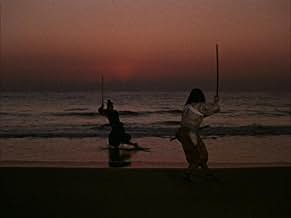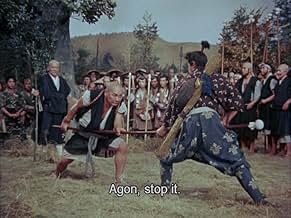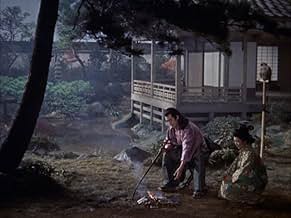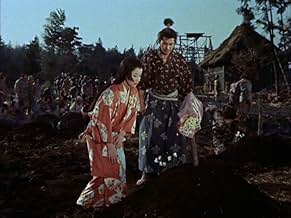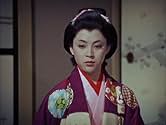La Voie de la lumière
Titre original : Miyamoto Musashi kanketsu-hen: Kettô Ganryû-jima
- 1956
- Tous publics
- 1h 45min
NOTE IMDb
7,5/10
7 k
MA NOTE
Kojiro Sasaki, un talentueux samouraï, lance un duel à Musashi. Ce dernier se retire alors un an à la campagne en attendant le moment de la confrontation. Là, il est rejoint par Otsu et Akem... Tout lireKojiro Sasaki, un talentueux samouraï, lance un duel à Musashi. Ce dernier se retire alors un an à la campagne en attendant le moment de la confrontation. Là, il est rejoint par Otsu et Akemi qui se disputent la place auprès de leur aimé.Kojiro Sasaki, un talentueux samouraï, lance un duel à Musashi. Ce dernier se retire alors un an à la campagne en attendant le moment de la confrontation. Là, il est rejoint par Otsu et Akemi qui se disputent la place auprès de leur aimé.
- Réalisation
- Scénario
- Casting principal
Avis à la une
1st watched 4/19/2003 - 7 out of 10(Dir-Hiroshi Inagaki): Sweeping romantic Hollywood-like epic from Japan that just happens to be about a Samurai. This is the last in a trilogy of films about Mr. Musashi(played by Toshiru Mifune) and his Samurai journeys. This one plays more like a romantic piece with two women fighting(bawling & brawling) over the affections of this strong-willed but soft-hearted hero and brave warrior. It's awesome to see a film made in Japan where the warrior hero cares about more than killing his opponent. The obvious issue of honor is foremost in this Samurai's mind and the killing just comes with the job. So many films that Americans were introduced to from Japan were either silly Godzilla-type movies or karate flicks(with almost no heart, but a lot of fighting). This is the kind of movie that Japan is probably very proud of, but is not often seen by American audiences. Bravo to Criterion for putting this into their DVD collection!! Now I'd just like to see the 1st two pictures in the trilogy to know more about what happened to the characters prior to this film. The climatic duel is also `one-of-a-kind' and has to be seen to be appreciated. I'll just leave it at that without giving too much away. Give this one a shot, you'll be glad you did!
Samurai III boasts far superior color and composition to the first installment. The opener includes a beautiful scene of Kojiro and Akemi by a magnificent waterfall. This sets the stylistically polished tone of the film, a nice attempt to revive our interest in the sometimes-stalling narrative (Will Kojiro fight the indestructible Musashi? Is Otsu going to get her man after spurning his inviting advances?)
In terms of eye candy, this finale gives the most exotic colors (some may complain as "un-Japanese"), the best lighting, and the most skin of Mifune's Musashi! The story continues with the intellectual and spiritual education of Musashi. Even though the final duel is set up to be his moment of self-realisation, it is preceded by a tad-curious sequence of Musashi's farmlife. Very reminiscent of the samurai-villager relationship in Seven Samurai, Musashi becomes their protector against bandits. The result is formulaic but does what the story intends: return Musashi to a life of the earth - a humanist existence preached by his Buddhist education - and to his humble origin.
P.S. Although Miyamoto Musashi/Samurai I is crucial to understanding the rise of our hero, it probably got Best Foreign film for 1955 Academy Awards during the sudden "discovery" of Japanese films starting with Rashomon.
And if you're looking for a female figure with as much spunk as Musashi himself, note the courtesan in Samurai II. Her chastisement of Musashi, that he lacks humanly affection and thinks of women as weaklings, almost makes up for the overall iffy portrayal of "romantic heroines" in the trilogy!
In terms of eye candy, this finale gives the most exotic colors (some may complain as "un-Japanese"), the best lighting, and the most skin of Mifune's Musashi! The story continues with the intellectual and spiritual education of Musashi. Even though the final duel is set up to be his moment of self-realisation, it is preceded by a tad-curious sequence of Musashi's farmlife. Very reminiscent of the samurai-villager relationship in Seven Samurai, Musashi becomes their protector against bandits. The result is formulaic but does what the story intends: return Musashi to a life of the earth - a humanist existence preached by his Buddhist education - and to his humble origin.
P.S. Although Miyamoto Musashi/Samurai I is crucial to understanding the rise of our hero, it probably got Best Foreign film for 1955 Academy Awards during the sudden "discovery" of Japanese films starting with Rashomon.
And if you're looking for a female figure with as much spunk as Musashi himself, note the courtesan in Samurai II. Her chastisement of Musashi, that he lacks humanly affection and thinks of women as weaklings, almost makes up for the overall iffy portrayal of "romantic heroines" in the trilogy!
Samurai III: Duel on Ganryu Island is the closing film of Inagaki's Samurai trilogy, the story of Musashi Miyamoto (Mifune). It is one of the best samurai films on its own and has the advantage of having the characters' history established in the first two films of the trilogy. This film abounds in good characters: Musashi's two disciples, a young boy and a horse trader, who exchange good natured barbs and loyally support Musashi; the two women in Musashi's life, good girl Otsu and bad girl Akemi; the brigand leader and his henchman, who was formerly Akemi's stepfather; and of course, Musashi's nemesis, Kojiro Sasaki, who is outstanding in both this film and Samurai II. Kojiro is actually a more interesting character than Musashi and reminds me of Tatsuya Nakadai's performance in Sword of Doom. The climactic duel on the beach with the rising sun in the background is amazing. Side note: This film has four of Kurosawa's Seven Samurai actors: Mifune, Shimura, Kato and Chiaki. See the whole trilogy.
This was, by far the best of the trilogy and a fine ending. It had less Samurai action that the other two, but it was much more inspiring.
Kojiro (Koji Tsuruta) thought himself the best in the land and sought a duel with Musashi (Toshirô Mifune). But Musashi wanted to devote his life to becoming a better person. he went back to the land that he rejected and became a farmer.
In the meantime, both Otsu (Kaoru Yachigusa) and Akemi (Mariko Okada) managed to find him. Can you imagine that scene? Feeling rejected, Akemi is made to betray Musashi to the brigands. The effort fails and Musashi accepts the duel with Kojiro.
The duel itself was magnificent but short. It was a fitting end to a film that featured outstanding cinematography and a compelling story of the drive to perfection.
Kojiro (Koji Tsuruta) thought himself the best in the land and sought a duel with Musashi (Toshirô Mifune). But Musashi wanted to devote his life to becoming a better person. he went back to the land that he rejected and became a farmer.
In the meantime, both Otsu (Kaoru Yachigusa) and Akemi (Mariko Okada) managed to find him. Can you imagine that scene? Feeling rejected, Akemi is made to betray Musashi to the brigands. The effort fails and Musashi accepts the duel with Kojiro.
The duel itself was magnificent but short. It was a fitting end to a film that featured outstanding cinematography and a compelling story of the drive to perfection.
I have seen the three films in one shot, and I have to say: AMAZING ! Samurai's life is a must know: honor, proud, philosophy it was a way of life. The three films from Inagaki are really great: good photography, well directed moving camera, it really seems that you are eating rice in the middle of the 17th century in Japan. This is also due to the language, its japanese...yes Japanese, but doesn't matter because it's better ! The strength in the talks are only comprehensive in the native language. If you like adventure, historical, romance or action movies you MUST see this three films (cannot be considered one to one). Inagaki received the Oscar in 1955 for Samurai I, thats all. And enjoy!
Le saviez-vous
- AnecdotesThis film is part of the Criterion Collection, spine #16.
- GaffesAs the final duel is fought, the duelists have light on the sides of their bodies away from the sun - Sasaki has light on his back and Miyamoto light on his face.
- Citations
Musashi Miyamoto: Brace up, Akemi.
- ConnexionsFeatured in Sayonara Jupitâ (1984)
Meilleurs choix
Connectez-vous pour évaluer et suivre la liste de favoris afin de recevoir des recommandations personnalisées
- How long is Samurai III: Duel at Ganryu Island?Alimenté par Alexa
Détails
- Date de sortie
- Pays d’origine
- Langue
- Aussi connu sous le nom de
- Samurai III: Duel at Ganryu Island
- Lieux de tournage
- Société de production
- Voir plus de crédits d'entreprise sur IMDbPro
- Durée1 heure 45 minutes
- Mixage
- Rapport de forme
- 1.37 : 1
Contribuer à cette page
Suggérer une modification ou ajouter du contenu manquant

Lacune principale
By what name was La Voie de la lumière (1956) officially released in India in English?
Répondre



